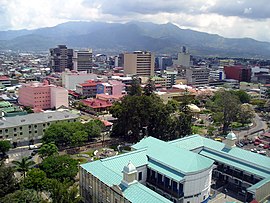IMF...........................................WB..........................................................CIA
rank/measure...............................rank/measure........................................rank/measure
70/5,904..................................63/5,653..................................................69/6,342
| Economy of Costa Rica | |
|---|---|
 | |
| Currency | Costa Rican colón |
| Fiscal year | calendar year |
| Trade organisations | CAFTA |
| Statistics | |
| GDP | $58.6 billion (2012, PPP) |
| GDP growth | 4.8% (2012, Real) |
| GDP per capita | US$12,600 (2012) |
| GDP by sector | agriculture: 6.2% industry: 21.1% services: 72.7% (2012) |
| Inflation (CPI) | 4.5% (2012, CPI) |
| Population below poverty line | 21.3% (2010 est.)[1] |
| Gini coefficient | 47.9 (1992-2007) |
| Labour force | 2.198 million (2012)note: this official estimate excludes Nicaraguans living in Costa Rica |
| Unemployment | 7.9% (2012) |
| Main industries | microprocessors, food processing, medical equipment, textiles and clothing, construction materials, fertilizer, plastic products (2012) |
| Ease of doing business rank | 121st[2] |
| External | |
| Exports | $11.47 billion (2012) |
| Export goods | bananas, pineapples, coffee, melons, ornamental plants, sugar; seafood; electronic components, medical equipment (2012) |
| Main export partners | |
| Imports | US$16.79 billion (2012) |
| Import goods | raw materials, consumer goods, capital equipment, petroleum, construction materials (2012) |
The economy of Costa Rica is very stable, and depends essentially on tourism,agriculture, and electronics exports.
According to a study conducted by ADEN Business School (which included 18 other countries in the region), Costa Rica is the fourth most competitive country in Latin America in 2012 and is part of a bloc of countries rated as having a "very good competitive level, with advances and developments in infrastructure, technology andmacroeconomic stability". The nation scored a 71,8 out of 100 on a study which measured competitiveness based on 10 criteria. Compared to the 2011 rank, Costa Rica went up by one position (form 5th to 4th).[6]
The CIA World Factbook states that Costa Rica's GDP per capita is US$11,900 (2011 est.); however, poverty has remained around 15-20% for nearly 20 years, and the strong social safety net that had been put into place by the government has eroded due to increased financial constraints on government expenditures.
It also states that foreign investors remain attracted by the country's political stability and relatively high education levels, as well as the incentives offered in the free-trade zones. According to the CIA World Factbook, Costa Rica has attracted one of the highest levels of foreign direct investment per capita in Latin America. However, many business impediments remain such as high levels of bureaucracy, legal uncertainty due to overlapping and at times conflicting responsibilities between agencies, difficulty of enforcing contracts, and weak investor protection.
Inflation rose to 22.5% in 1995, dropped to 11.1% in 1997, 12% in 1998, 11% in 1999 and 13% in 2008. Measures taken by the Central Bank have reduced inflation substantially to 4.3% in 2009, and a projected 5.8% for 2010. Curbing inflation, reducing the deficit, and improving public sector efficiency through an anti-corruption drive, remain key challenges to the government. Previous political resistance toprivatization had stalled liberalization efforts. However, after the signing of CAFTA, Costa Rica is now opened to competition in its insurance and telecommunications markets.
Costa Rica's economy emerged from recession in 1997 and has shown strong aggregate growth since then. After 6.2% growth in 1997, GDP grew a substantial 8.3% in 1999, led by exports.
The strength in the nontraditional export and tourism sector is masking a relatively lackluster performance by traditional sectors, including agriculture. The central government deficit decreased to 3.2% of GDP in 1999, down from 3.3% from the year before. On a consolidated basis, including Central Bank losses and parastatal enterprise profits, the public sector deficit was 2.3% of GDP.
Controlling the budget deficit remains the single biggest challenge for the country's economic policy makers, as interest costs on the accumulated central government debt consumes the equivalent of 30% of the government's total revenues. This limits the resources available for investments in the country's deteriorated public infrastructure, investments in many cases that would result in higher quality infrastructure if they were better planned.